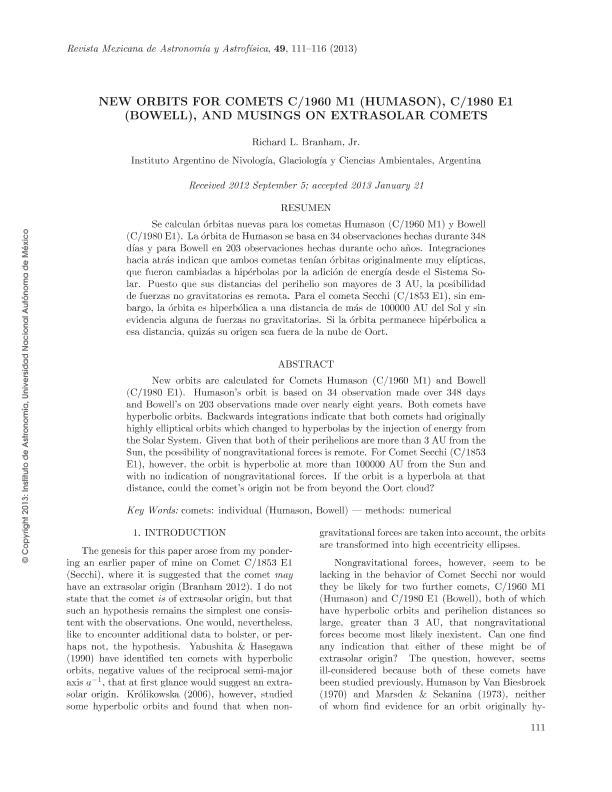Mostrar el registro sencillo del ítem
dc.contributor.author
Branham, Richard Lacy

dc.date.available
2017-11-30T17:20:41Z
dc.date.issued
2013-04
dc.identifier.citation
Branham, Richard Lacy; New orbits for Comets C/1960 M1 (Humason), C/1980 E1 (Bowell), and musings on extrasolar comets; Universidad Nacional Autónoma de México. Instituto de Astronomía; Revista Mexicana de Astronomía y Astrofísica; 49; 1; 4-2013; 111-116
dc.identifier.issn
0185-1101
dc.identifier.uri
http://hdl.handle.net/11336/29347
dc.description.abstract
Se calculan órbitas nuevas para los Cometas Humasen (C/1960 M1) y Bowell (C/1980 E1). La órbita de Humasen se basa en 34 observaciones hechas durante 348 dias y para Bowell 203 observaciones hechas durante ocho años. Integraciones hacia atras indican que ambos cometas tenían orbitas originalmente muy elípticas cambiadas a hipérbolas por la adición de energía desde el sistema solar. Puesto que sus distancias del perihelio son mayores de 3 AU, la posibilidad de fuerzas no gravitatorias es remota. Para el Cometa Secchi (C/1853 E1), sin embargo, la orbita es hiperbolica a una distancia de mass de 100.000 AU del sol y con ninguna evidencia de fuerzas no gravitatorias. Si la orbita queda una hipérbola a esa distancia, quizás su origen sea fuera de la nube de Oort.
dc.description.abstract
New orbits are calculated for Comets Humasen (C/1960 M1) and Bowell (C/1980 E1). Humasen’s orbit is based on 34 observation made over 348 days and Bowell’s on 203 observations made over nearly eight years. Both comets have hyperbolic orbits. Backwards integrations indicate that both comets had originally highly elliptical orbits changed to hyperbolas by the injection of energy from the solar system. Given that both of their perihelions are more than 3 AU from the sun, the possibility of nongravitational forces is remote. For Comet Secchi (C/1853 E1), however, the orbit is hyperbolic at more than 100,000 AU from the sun and with no indication of nongravitational forces. If the orbit is a hyperbola at that distance, could the comet’s origin not be from beyond the Oort cloud?
dc.format
application/pdf
dc.language.iso
eng
dc.publisher
Universidad Nacional Autónoma de México. Instituto de Astronomía

dc.rights
info:eu-repo/semantics/openAccess
dc.rights.uri
https://creativecommons.org/licenses/by-nc-sa/2.5/ar/
dc.subject
Comets: Individual (Humason, Bowell)
dc.subject
Methods: Numerical
dc.subject.classification
Astronomía

dc.subject.classification
Ciencias Físicas

dc.subject.classification
CIENCIAS NATURALES Y EXACTAS

dc.title
New orbits for Comets C/1960 M1 (Humason), C/1980 E1 (Bowell), and musings on extrasolar comets
dc.type
info:eu-repo/semantics/article

dc.type
info:ar-repo/semantics/artículo
dc.type
info:eu-repo/semantics/publishedVersion

dc.date.updated
2015-04-06T14:31:40Z
dc.journal.volume
49
dc.journal.number
1
dc.journal.pagination
111-116
dc.journal.pais
México

dc.description.fil
Fil: Branham, Richard Lacy. Consejo Nacional de Investigaciones Científicas y Técnicas. Centro Científico Tecnológico Conicet - Mendoza. Instituto Argentino de Nivología, Glaciología y Ciencias Ambientales. Provincia de Mendoza. Instituto Argentino de Nivología, Glaciología y Ciencias Ambientales. Universidad Nacional de Cuyo. Instituto Argentino de Nivología, Glaciología y Ciencias Ambientales; Argentina
dc.journal.title
Revista Mexicana de Astronomía y Astrofísica

dc.relation.alternativeid
info:eu-repo/semantics/altIdentifier/url/http://www.redalyc.org/articulo.oa?id=57126152012
dc.relation.alternativeid
info:eu-repo/semantics/altIdentifier/url/http://ref.scielo.org/y4276p
Archivos asociados
